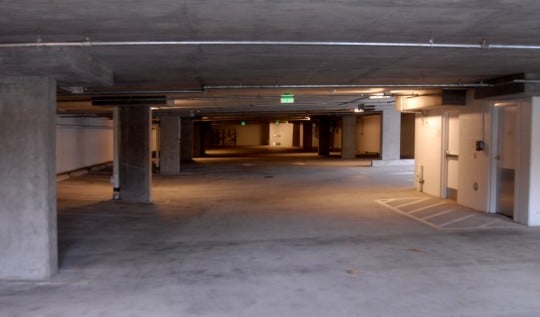
(Photos: M.Andersen/BikePortland)
When Steven Van Zile moved from Los Angeles to the Pearl District last year for a job managing Guardian Management’s portfolio of Portland-area apartment buildings, the low number of parking spaces at some of the newer properties made him nervous.
Linden, the company’s new building on Burnside and 12th, had only 110 parking spaces for 132 units. In an interview at the time, Van Zile expressed gratitude to the building’s developer that the on-site parting lot was larger than at some other buildings. But what would happen if garage space ran short?
It turns out that Van Zile needn’t have worried.
A year after it opened, Linden is 98 percent full. Its one-bedrooms start at $1,295 a month for 576 square feet; a 922 square foot two-bedroom is $2,085. Parking in the on-site lots adds another $139 for the upper level, $110 for the lower.
The lower garage, however, is completely empty.
Of cars, that is.
Bike parking at Linden, meanwhile, has been swamped.
When I stopped by the building’s garage in late August, I saw every rack full:
I saw a bike locked to a pole inside the garage:
I saw bikes locked to the bars of the windows:
I saw a bike locked to a bike:
There are also bikes being stored on maybe half the balconies outside the building:
Brandy Guthery, Linden’s on-site manager, said the building has been working hard to keep up with the demand for bike parking.
“We’ve already installed more, and now we’re installing even more,” she told me in August. As for all the empty auto parking spaces, Guthery predicted that once winter came, Linden residents who have been parking their cars in the street for free would begin moving indoors.
If that’s true, it hasn’t happened yet. Guthery said in a follow-up interview Wednesday that garage occupancy is exactly what it was in August: three spaces open in the upper garage, every space open in the lower one.
Linden’s bike parking situation is unusual, because the building was first approved as a senior housing development. During the city’s review process, Linden’s developers asked for and received a waiver from the city’s requirement that the building include at least 1.1 bike parking spaces for every unit. However, late in the process, Linden’s developers changed course and decided to market the building as a higher-end building for singles and small families — an approach that has apparently worked well when it comes to filling bedrooms.
It’s not clear how many Linden residents have ended up parking off site and how many don’t own cars at all.
“I live a couple of blocks from the Linden, and I haven’t heard any complaints about parking spillover,” said Greg Moulliet, co-chair of the Buckman Community Association.
But Susan Lindsay, the association’s other co-chair, said parking spillover “has been an ongoing situation with many of the new apartment buildings recently built, even if there is some included parking.”
In any case, Linden’s auto parking situation captures a larger phenomenon in central Portland housing right now: a year after the city, responding to a wave of neighborhood complaints, began requiring new buildings of more than 30 units to include on-site auto parking even if they’re on a frequent bus line, many of the new parking spaces aren’t keeping cars off the streets.
“The reality is we can’t force people to pay for it,” developer Aaron Jones told the Portland Tribune this month after trying and failing to rent parking spaces for $85 a month near his apartment project at 48th and Division.
Developers charge for on-site auto parking because each auto parking space within the footprint of a building costs $20,000 to $55,000 to develop by taking up space that might otherwise be used for revenue-generating housing. Surface parking is cheaper to build, but still costly because a parking lot could otherwise be an entire apartment building.
Another option for developers would be to bundle parking into the cost of a unit, raising the rent for every tenant whether they use parking or not.
“These people do indeed bike. And they walk and they bus. But they still have cars.”
— William Gregg, Buckman Community Association
As it is, some residents who rarely use their cars seem to be finding that parking a few blocks from their home isn’t a big burden — at least when the price is $0.
“These people do indeed bike,” said William Gregg, a Buckman Community Association member who lives near a new apartment building at Southeast 12th and Taylor and who sits on the stakeholder committee for the Portland Bureau of Transportation’s new study of auto parking. “And they walk and they bus. But they still have cars.”
“They’re not just parking, they’re using the street for storage,” he added. “I’ve got cars parked back here that hasn’t moved for two weeks.”
Meanwhile, though the new building near his house is now half occupied, Gregg said its garage is empty. He said the developer is asking $120 to $150 for spaces in its parking area.
“I don’t see anybody parked there at midnight,” he said. “Not a single car.”
Correction 10/24: An earlier version of this post incorrectly described Gregg’s position with the Buckman Community Association. He is a member but not a board member.
— The Real Estate Beat is a regular column. You can sign up to get an email of Real Estate Beat posts (and nothing else) here, or read past installments here. This sponsorship has opened up and we’re looking for our next partner. If interested, please call Jonathan at (503) 706-8804.



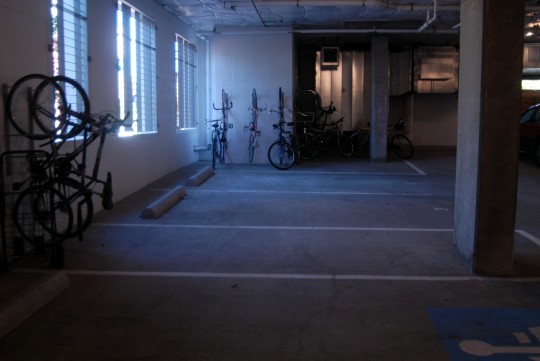
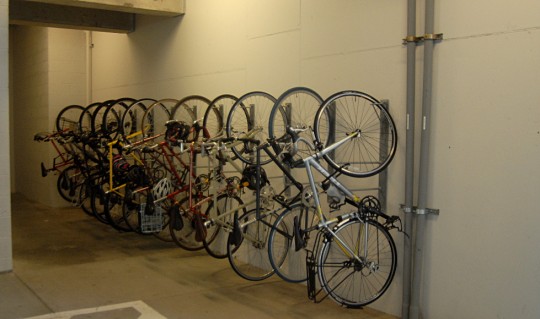
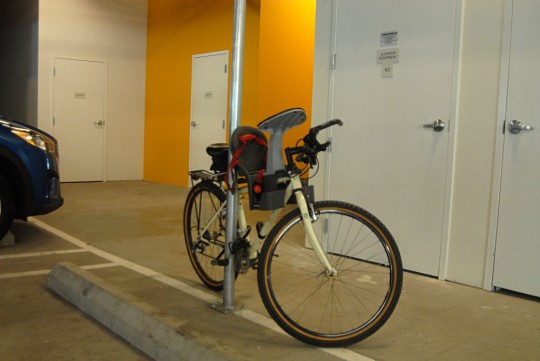
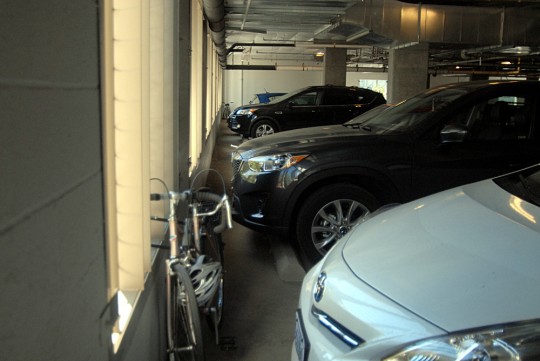
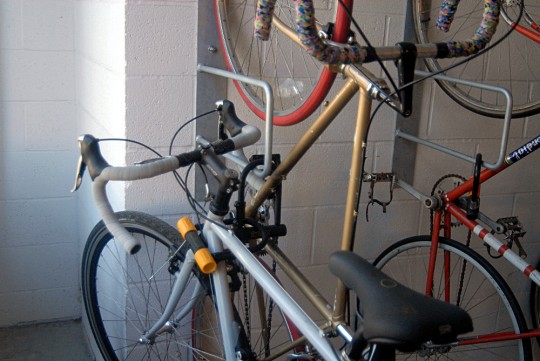
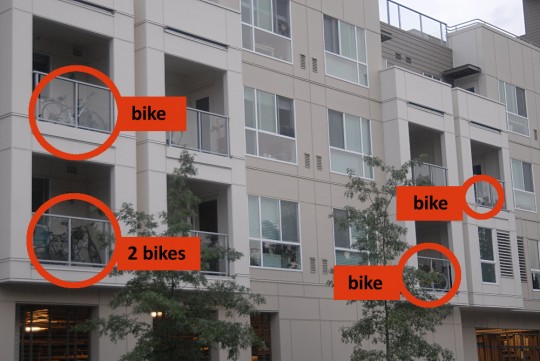
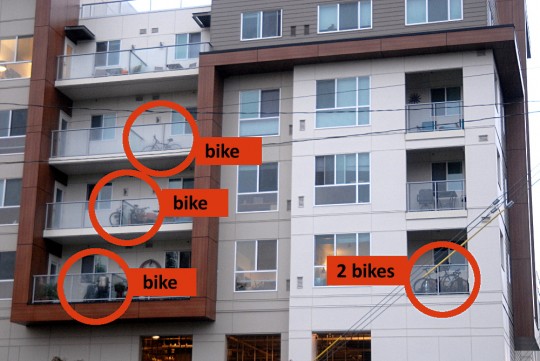

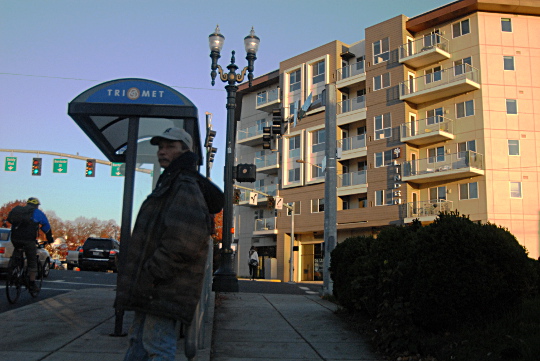
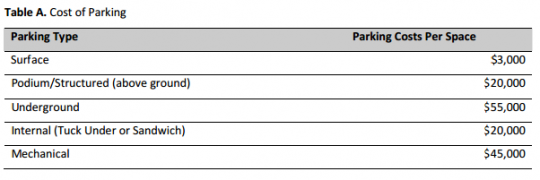


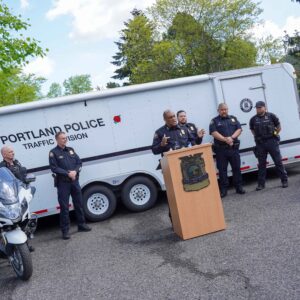
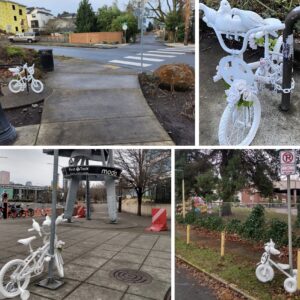
Thanks for reading.
BikePortland has served this community with independent community journalism since 2005. We rely on subscriptions from readers like you to survive. Your financial support is vital in keeping this valuable resource alive and well.
Please subscribe today to strengthen and expand our work.
This will only continue to be the case if parking is required in apartments, but there isn’t subsequent pricing of on-street parking. Why would you pay $120 a month to park when you can do so for free on the street? Especially if you don’t use your car very often.
If folks are leaving their cars in the same spot for more than a day or two – it might be time to look into some parking enforcement in the area. That’ll bring up the cost of on-street parking and make paying to store their cars a little more appealing.
Exactly – apparently the city rule for on-street parking is that the car must be moved every 24 hours. https://www.portlandoregon.gov/transportation/article/319887#allday Start ticketing violators, and I bet Steven would be able to fill that lower garage.
“Exactly – apparently the city rule for on-street parking is that the car must be moved every 24 hours.”
Yes, and IMO that’s one of the stupidest laws ever. I know some people here applaud it because it discourages car ownership, but I see it as the exact opposite: it even more strongly incentivizes people who own cars to drive them every day. The reality, of course, is that enforcement is based on the usual capricious complaint-driven process.
If you changed the law to require cars to be moved once a week you’d still deal with the abandoned-car problem, and you wouldn’t be encouraging daily driving.
> “Exactly – apparently the city rule for on-street parking is that the car must be moved every 24 hours.”
> Yes, and IMO that’s one of the stupidest laws ever. … it even more strongly incentivizes people who own cars to drive them every day.
And it forces spaces to free up for others, which might be a great thing if the goal of your parking policy was to free up spaces (say, in front of businesses). But in neighborhoods where people live, policies should actually do the opposite, encouraging people to leave their cars alone for days at a time (or get rid of them).
There are at least two ways to do that:
1. Free parking for everyone, with _no enforcement_. (Consider how expensive enforcement is: when paired with a $0 parking scheme, enforcement means the city starts with no revenue and ends up with negative money the more it enforces!)
2. Monthly parking permits. Because the parking permit is for much longer than a day, there is no incentive for people to drive. And because the permit need to be paid again every month, there is a monthly incentive to ditch the car.
The great thing about parking permits is that you don’t even need to spend much on enforcement. Permit-holders will enforce it themselves, when they will struggle to find parking and notice a car without a permit parked in the street, they’ll call the police themselves to get it towed.
That will never happen, simply because PPB would then be required to also (fairly) ticket people who park in front of their own house. Homeowners run the neighborhood associations, and thus the NA would never support such enforcement.
The best that a neighborhood association is going to do is setup a permit system and make sure apartment renters can’t get permits.
BTW: Even if a car has been sitting there for two months, parking enforcement will not ticket them just for that. They will only ticket for expired tags, inoperable vehicle, if it’s a trailer or RV, etc.
I know, I tried to get parking enforcement to ticket the little old ladies who used to park in front of my house for 6 weeks at a time.
I’ve had good luck with getting parking enforcement to ticket cars parked longer than 24 hours… other violations not so much… maybe it depends on where the violation is…
They will ticket if someone complains. Happened to my tenants.
Here Here.
Alas, almost all parking enforcement outside of metered zones is complaint-driven, putting the burden on citizens to continually call in these violations of parking code. I hope PBOT’s upcoming effort to tackle parking reform includes a provision to ensure parking enforcement is proactive, citywide.
It should be complaint driven. Proactive monitoring of parking costs a lot of money, and outside of the metered or zoned parking areas there’s no revenue stream to pay for that.
I don’t like begging the parking enforcement people to ticket violators any more than I like pushing a button to beg to cross the street…
there should be regular patrols of all streets in the city… they have license plate readers with gps and they know if you’ve been there too long… whatever happened to putting a chalk line on people’s tires?
Very well done! It should be pointed out that the Linden’s 110 spaces are far more than the City required. In the old rules, the minimum requirement would have been 0; under current rules, it is 44 spaces. (33.266.110.D.1.d) The developer clearly over-anticipated demand, and it’s costing them. Huge props to them, though, for “unbundling” housing from parking. What’s weird is that they haven’t lowered prices. When a substitute (street parking) is free, $110/mo. seems high, even given the security and weather-protection advantages.
Agreed. This should be a lesson learned for them and other developers. Some parking is probably justified, but aiming for a 1 to 1 ratio isn’t going to pay off. Don’t know why they wouldn’t just lower prices. 50 parking spaces paying $70 each is a lot more revenue than zero. Also seems like an opportunity to convert some of the empty spaces to more high quality bike parking.
Most of the people who have not bought parking spaces are paying $0 a month currently for street parking (or for not owning a car). What price would they be willing to pay? If it is only $40 or $25 a month, the building owners make more money with a 1/2 full garage at $100 a month per space.
how about GASP, permitted on street parking in every neighborhood inside 82nd ave?
This, a thousand times this. If you are in the city limits, your parking on publicly maintained property should not be free. It should pay for the roads.
Permit parking as it exists today is intended solely to make sure “those people” don’t come and take up “our parking.” The $60/yr does not pay for anything beyond the administration of the program.
Just like cyclists pay for roads through fees and taxes, so do drivers.
You mean 92nd.
In reality though there are really almost no parking issues east of 52nd or so.
Today I learned that when you offer an off-street space in a part of town with completely subsidized on-street parking, people will choose to save money instead of paying for the convenience of a garage.
Look at the parking garages in any meter district and it’ll be a vastly different situation.
“people will choose to save money instead of paying for the convenience of a garage.”
Saving money? These apartments go for about 2x what they should, given I just rented a top of the line 4 bedroom house @2100 sq feet (with a garage with space for about 20-25 bikes) at the same cost as their 922 sq foot place. I also don’t have noisy Burnside/Sandy traffic 24/7. Location is one thing, but man, Burnside is a 20 minute bike ride from my house.
You’re not comparing apples to apples.
You & I (inner-Portland single-family homedwellers) are massively subsidized by the zoning of huge amounts of close-in eastside Portland for single-family homes only. It’s nice for us lucky few, sure, but is it good policy?
Alex, you really consider FoPo an “inner” neighborhood?
Eh, borderline. If it’s a choice between “inner” and “outer,” then definitely “inner” – and becoming more so; housing prices and the income distribution have been climbing rapidly in the past few years. If “mid” is an option, “mid” fits better.
I hope you’re not going to try propose policy that calls for close in eastside and other close in Portland neighborhoods, to be zoned for apartment buildings only. There may be a lot of people still, that really don’t want to live in apartment buildings. Doesn’t seem like good policy to build housing that people don’t want to pay to live in, or live in at all.
Each to their own. Still seems to be a market for single family dwellings, or land wouldn’t be zoned for them. Government and cities still seem to be getting a good bit of tax revenue from people that own and live in that type housing. Nice to have a driveway or a garage to park a car, or to use it to store a lot stuff. A yard for kids and dogs, a garden. Nice exposure to the sun.
No, just for policy that has less area zoned single-family only. Plenty of cities have a nice mosaic of single-family, duplexes, rowhouses, multiplexes, and low/mid-rise apartment buildings. We have apartment buildings along the noisy, dangerous, busy streets and single-family homes (and a few duplexes) everywhere else.
Not to say that the busy streets aren’t also vibrant, exciting, and walkable (well, some of them. Powell is pretty much just noisy, dangerous, and busy). But the “noisy, dangerous, busy” is a reason why plenty of people don’t like our current apartment offerings. I have a friend who’s renting out a 360-sq.ft. ADU in the inner eastside (but not really that close-in) for more than $1000 – and had close to twenty applicants. People who only want/need smaller quarters but don’t want to live on a busy street have precious few options here.
“We have apartment buildings along the noisy, dangerous, busy streets”
that also most often, happen to be the closest to public transportation.
True, but it’s one block in from the major streets / public transit routes that is zoned single-family only, not 10 blocks in (a distance that I see as being a reasonable barrier to transit for able-bodied people)
I’d also say to just zone those areas “low-rise or smaller residential” and allow all those building types. If someone wants a single-family house near 24th & Lincoln and is willing to pay for it, great. If someone else wants to build a 6-plex next door, I don’t see why that should be a problem.
A mix of different housing types together, sounds like an idea that could possibly help counter the tendency some people seem to have, to be willing live a long commute away from their job, if that’s what they’ve got to do to live in a house rather than an apartment.
I think of Orenco out in Washington County as an example. Situated near both light rail and big hi tech employers such as Intel, that community would seem the sure thing in terms of providing walkable commutes and short biking commutes to work, schools, services. That is, if a sufficient range of housing types and quantities, that people working in the area desire, exist within the walking and short commute by bike range.
Doesn’t seem to be the case, to the extent that traffic congestion on area roads and highways can be relied upon as an indicator.
Spiffy, people definitely have different preferences in housing types. Some feel that living in an urban apartment, no yard and house to maintain and clean up, is great. Others despise the idea of having neighbors one thin wall from them, above, below or both. They may much prefer their child having a backyard to play in at least some of the time, rather than having to walk to the park.
There’s up and downsides to both housing types, and the market for one or the other, isn’t likely to disappear completely, anytime soon. Housing and communities accordingly, should be built well, intelligently, so they’re appealing, function well, and offer sufficient range of choices, without continually looking beyond the urban growth boundary for land to do so with.
Agreed! Orenco seems like a place that is a good start, but suffers from the wider area that it’s in (which is sprawly, with bad/inconsistent bike/ped/transit provision).
Except there is a problem with building a multi-family dwelling next door to a single-family dwelling and that’s the type of occupant. Single-family will likely be owner-occupied while the multi-family dwelling will be occupied by renters. These groups display vastly different behaviors. When I owned in suburban Detroit, the neighborhood was a “mosaic” but not a pretty one. It was very clear which were the owner-occupied and which were rented. The rented properties were generally run down, dirty with trash strewn about, etc. And, yes, we owners were hurt by it when selling our homes.
the amount of land on the planet isn’t expanding as fast as the population… if we don’t start stacking people we’ll run out of space… you’ll either have to live in an apartment or pay way, WAY more to live in a house…
I don’t want a yard to upkeep, I take my kid to the park, just like people used to do on the east coast before the “american dream” gave them their own yards…
And zero minutes for them
True that. These folks can walk out their front door to pubs/etc and this other guy has to bike 40 min round trip…
The parking on the lower level is a developer concession for the Imago Dei church. So that is not part of the available supply as no resident parking is allowed. Nonetheless, it is a big waste of space. The biggest issue is the lack of SECURE bike parking supply. There have been about 15 thefts over the last 3 months. After theft #15, building management realized it was an actual problem and instituted some security changes.
Also related to parking spillover…look at the old Old Wive’s Tale surface lot across the street. Always full at night.
You’re saying the big empty lower level parking that bikeportland shows in its photo, has been reserved for exclusive use by the Imago Dei church. Unless tenants of the Linden are going to the church, they can’t park there.
Imago Dei also offers parking at Buckman School on Sunday with a shuttle van offering rides for those unable/unwilling to walk the four blocks between the school and the church. I shall also add that this is rarely used because the Sunday churchgoers seem to strongly prefer to park on the surface streets.
Yes, only to be used for 6-ish hours on Sunday. A new model for space efficiency…
This is news to me, and I’ve been going to Imago Dei for over 3 years (which includes before the Linden was built, and there was actually a church parking lot on the site).
http://www.imagodeicommunity.com/article/sunday-parking-and-check-in/
The Linden says it is renting out the bottom garage, so I don’t think it is reserved for church use.
A 2011 condition from the City requires Linden’s lower level parking to be available for the church use, but only in a very limited way: “to be reserved for church use on Sundays, church holidays and other times that church activities bring large numbers of members or visitors to the neighborhood.” (Portland land use case LU 10-161634 CU AD, condition B) Therefore, those spaces are available to satisfy resident demand, if residents are willing to relocate to free street parking once a week for six hours. Maybe that explains why the price is $29/month less for those spaces.
I stand corrected, thanks.
I’m curious if the church knows this, as they clearly aren’t “advertising” the spots to their people.
As I stated above, this was originally owned and used as a church lot, and the original story we were told is that the building would be residential for retirement age folks (as pointed out in the story), and would have some affiliation with the old church group that used to own the land and sold it to Imago Dei.
benschon…thanks! The information you’ve provided, makes much more sense than does the idea that an entire lower parking level of an apartment building could be off limits to residents at all times, so as to have it reserved for the church for just six hours a week. It could be helpful to readers, if this information was included above in the bikeportland story.
It seems to me also, that the inconvenience to tenants paying for parking on the lower level and having to relocate their cars elsewhere when church activities are taking place, may justify more than the $29 reduction off the price of the upper level. Cutting the price substantially, could help to free up a lot of street parking spaces, possibly allowing some street parking to be eliminated completely. Free space thus created, could in turn possibly make more room for things like bike lanes.
Maybe some of that excess parking could be leased out to the tenets in the new apartment across the street that is going to the built where the Old Wives Tales was located. We really need to be smarter about how we use our existing space.
1) Phasing in parking permit requirements on all major streets. This is, presumably, easier and cheaper than parking meters.
2)Filling in areas with higher parking vacancy with bike facilities.
I often see on Knott and Killingsworth, for example, there are often scattered cars on both sides of the street, causing me to swerve into traffic for brief moments. If parking had a cost, this would likely limit the numbers even more. This would allow parking to be consolidated, limiting it to one side of the street, where a bike lane would be easy to fill in (and uncontroversial). This goes for a lot of streets when given a price on parking.
This is a simple and straightforward plan the city needs to start doing on all major streets.
You’d have to have permitted parking on side streets as well for it to work. But yes, I think all of inner Portland should be permitted and metered parking. We wouldn’t need a street fee then.
“causing me to swerve into traffic for brief moments”
that goes against the recommendations of the DMV handbook… please stay in the traffic lane…
If renting a parking space in a garage is decoupled from renting an apartment, it will allow neighborhood residents that complain about lack of parking to have the option of renting in the garage as well. Homeowners should not expect to always have a free on street parking spot in front of their house in neighborhoods that are densifying.
Its basically saying that if you’re going to add housing units to this neighborhood, you also have to provide off street parking options for the neighborhood.
In my younger dirty days in Portland, I had plenty of friends who lived in west side building with permitted on street parking. They avoided by moving their cars several times a day. It’s not to say it doesn’t work, just that true enforcement over such a large area is costly and tricky. I suppose Portland could contract out the work –seems I’m more likely to get a ticket in a private lot than on the street.
For the bikes not in the garages: even the most secure buildings (live security guards, cameras, electronic doors, etc) have bikes stolen (and cars with smashed windows) from garages. When I’m crashing in the Pearl, my bike goes upstairs. At work my bike goes inside. Parking garages are too easy for thieves to go unnoticed.
I’d pay for a dry, secure space to park and wrench on my bikes if there’s a shipping container that will fit.
Interesting idea. Can’t remember what prices are. Length, 20′ and 40′, may pose a challenge. Width 8′. The company, PODS, seems to do a great business with temporary storage containers. Made of plastic.
We got so many options now! Bike, walk, public transport, car share.
We don’t need all this empty space for cars.
But seriously parking policy is important. I would push for the formation of parking benefit districts where neighborhoods can capture value from parking fees (for maintaining the local streets and whatever the locals want) and current residents get to park free. New residents would have to pay after that. That is politically feasible, and will start to end the massive subsidy we provide car drivers.
They should turn all this empty garage space into a trampoline amusement park….
http://3.bp.blogspot.com/-yNIDEOyYQKs/UZu75qaF73I/AAAAAAAAB_U/d9LudbJmYx8/s1600/099.JPG
we don’t need to privilege existing residents with no restriction parking, they are as much of the problem as the new residents. their car causes parking and congestion problems as much as any other car does.
I totally agree. Parking reform is tough!!
Could it be that parking reform won’t happen without compromise? I think it’s important to make it politically feasible. There is no way to get parking reform without appealing to the existing sense of driver entitlement.
Has it really been a full year since the Linden was opened? Doesn’t fee like that long.
ha freudian slip!
My boyfriend and I recently moved into a brand new building at NE Couch and 20th that has zero car parking facilities. Shortly after, we had a local business owner tell us that it angered some of the neighbors that it didn’t have parking. But we don’t own a car, and I think we both assumed that someone moving into a place without parking wouldn’t own a car!
Somehow this sort of thing entered into my mind when looking at the proposition for creating driving cards for people w/o proof of residency. The arguments for suggest that everyone needs a car to drive to work, church and school, but look at how many residents can get by without a vehicle.
The city needs to start charging for on-street parking.
look at all that bike secured parking 😉
Unfortunately, the city ends up with < $0, because the city had to build the parking spot, and asphalt is genuinely expensive.
This article is a cherry picked single example. The building has 1 car parking spot per unit. The spaces on the lower level are reserved for churchgoers on Sunday. Of course the lower level will go unrented.
Citation?
Lazy?
Parking. Meters.
That is all.
Sounds like the parking garage and/or the street parking isn’t priced right… if the price were lower, more tenants wouldn’t “defect” to using street parking over using the garage reserved solely for their building’s use.
Has anyone pointed out that full bike parking and bikes on balconies only indicates bike ownership? It says nothing about whether these people commute to work on bikes or use them to get around for entertainment and recreation. If anything, the bikes being present at the building all the time suggests the opposite: these people own bikes but are not using them!